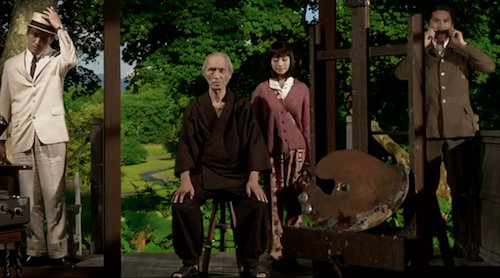« Alias Nick Beal | Main | The Whirlpool of Fate »
July 09, 2021
Nobuhiko Obayashi's War Trilogy

Casting Blossoms to the Sky / Kono sora no hana: Nagaoka hanabi monogatari (2012)

Seven Weeks / No no nanananoka (2014)

Hanagatami (2017)
Japanese filmmaker Nobuhiko Obayashi has been ill-served in the west, with the impression being that his career begins and ends with his narrative debut feature, House from 1977. The cult for that film is well-earned but unfortunately has not inspired anyone to import any of the twenty-odd films made prior to Casting Blossoms in the Sky. I have been able to see a small handful of those films made during this thirty-five year period, my favorite being The Discarnates (1988), described as a horror film but truly one of the saddest of ghost stories. The war trilogy does not quite bring interested viewers up to date of Obayashi's career as his final work, Labyrinth of Cinema is available for English language viewers as a streamer. Still, these three late films are very much welcomed.
The Japanese title roughly translates as "This Sky of Flowers: The Nagoaka Fireworks Story". There is quite a bit to unpack, and much of the film is very culturally specific. Reiko, a journalist, visits visits Nagaoka, a city on the western coast of Japan in early December, 2011. The city is about to commemorate the 70th anniversary of the attack on Pearl Harbor with a special fireworks show. Nagaoka, famous for its fireworks festival, was also the sight of almost total destruction of the city by U.S. bombs on August 1, 1945. The film weaves in and out of past and present as Reiko watches the preparation of a re-enactment of the bombing performed by high school students, and meets with several of the survivors. There is a mix of fictional narrative, documentary, actors and their real life counterparts, with emphatically obvious special effects and animation.
Reiko's initial reason for visiting Nagaoka is to understand by the city took in many people displaced by the tsunami and earthquake that took place in March 2011. Obayashi makes connections between personal tragedies and major disasters. At certain points, past and present, fact and fiction, exist within the same space. In its own way, Casting Blossoms to the Sky does not fail to remind the viewer of Obayashi's roots in experimental filmmaking.
War is a just a part of Seven Weeks. The title refers to the period of mourning following the death of a small-town doctor, Mitsuo Suzuki. The film takes place in Ashibetsu, in northern Japan, a mining town that had 70,000 residents at its post-war peak. At the time the film was produced, funded by the residents, the population had decreased to 16,000. The doctor's extended family meets in Ashibetsu where there is a tangle of personal memories and relationships, as well as the town dealing with the closure of most of the mines and the attempts to lure tourists.
Obayashi shows several of Suzuki's friends reflecting on their youth which coincided with what the Japanese termed "the Pacific War". What is depicted is an abstract memory of Suzuki seeking out a friend and a woman he loved that had gone to Sakhalin, the northernmost island that was the subject of conflict between Japan and Russia. Notably, Obayashi points to a part of history that is generally ignored by most history books, that for Japan, war continued after Hiroshima and Nagasaki, with Russia seeking to claim parts of northern Japan, with no resolution until September 1945.
The narrative shifts between past and present. Incidents are repeated as if a refrain from a poem. Clocks are always set at 2:46 pm. The film is also a mix of nostalgia for a Japan that has lost some of its cultural past, and optimism for a better future.
That sense of optimism has dissipated in Hanagatami, Obayashi's penultimate film. The screenplay was originally written prior to the production of House and shares some of that film's spookier elements. Although the story, seen through the eyes of a teenage boy in a remote part of pre-war Japan, is relatively straight-forward, Obayashi employs various distancing devices.
The most disorienting is having actors, especially the male leads, significantly older than their roles. The use of digital effects also creates an artificial environment that first announces itself with pink cherry blossoms in the otherwise black and white introductory scene. Toshihiko and other young men his age are anxious about the possibility of going to war, but also of the bigger question of having a life that is not considered wasted. The film was adapted from a short story by Kazuo Dan, published in 1936, which was also said to have inspired Yukio Mishima. Toshihiko openly admires two of his classmates who are strikingly different.
Toshihiko lives with his young aunt, Keiko, and cousin, Mina. Mina has tuberculosis, and is seen coughing blood into a well. Where Hanagatami and House seem similar is in Keiko's care for Mina which borders on the vampiric. Not so coincidentally, Mina is the name of one of Dracula's victims in Bram Stoker's novel. There is also a shot of a record label with the title "Phantom Nosferatu". Blood also turns into red petals. Even Mina's tombstone, marking her death on December 7, 1941, is streaked with blood.
The film ends with the present day Toshihiko looking back at how he has outlived his group of friends. Obayashi's director's chair is seen in the back, the filmmaker's signature of his most personal work.
The three films will be getting limited theatrical runs as well as being available to stream. Consider that each film has a running time of over two and a half hours in addition to attentive viewing. For screening information, check the KImStim website.
Posted by Peter Nellhaus at July 9, 2021 06:56 AM
